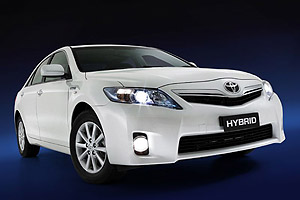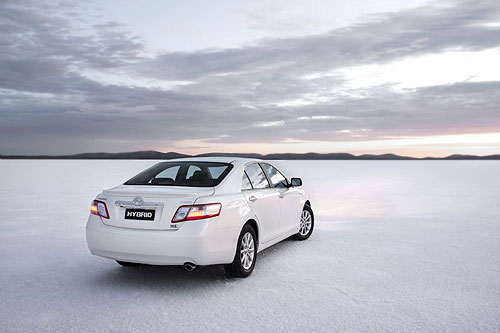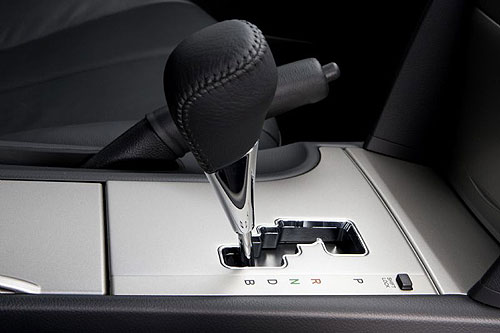 The new Hybrid Toyota Camry went into full production last week so now’s a good time to have a look at some of the styling features of the new model.
The new Hybrid Toyota Camry went into full production last week so now’s a good time to have a look at some of the styling features of the new model.
Toyota says that its new Hybrid Camry, which goes on sale in February, has been “designed with distinctive hybrid features and values that will be instantly recognisable by customers and other motorists.
“Unique exterior features for Hybrid Camry signify its importance as a model equipped with a hybrid system that features the latest technology” … and of course if you happen to miss all those “hybrid features” there are prominently displayed badges so that others will know that you’re driving a state-of-the-art piece of environmentally friendly technology.
Toyota Hybrid Camry is Australia’s most aerodynamically efficient locally manufactured car. It has a co-efficient of drag of 0.27, six per cent beneath its conventionally engined equivalent and its unique styling has been driven by a need to accommodate significant technical innovations.
Hybrid Camry incorporates Toyota Hybrid Synergy Drive with two electric motor-generators, as well as an inverter to convert alternating current from the motor-generators to direct current for storage in the Hybrid Vehicle (HV) battery, and direct current from the battery back to AC for the electric drive motor.
The inverter is water-cooled, with its own radiator and electric water pump.
The new package has placed emphasis on styling to provide solutions to positioning of components and the movement of cooling air and the design of Hybrid Camry has been a closely co-operative venture between styling and engineering. A clean, flat underbody was considered essential to delivering a low co-efficient of drag and achieving negative lift.

Specific attention has been paid to the detail of under-bonnet fitments, including electric motors to run Hybrid Camry’s drive-by-wire brake and steering systems. Clever packaging of the electric motor-generators and the two sets of planetary gears that link them mean the Toyota Hybrid System transaxle is similar in size to a conventional automatic transmission.

Positioning the hybrid battery behind the rear seat takes the vehicle’s fore/aft weight balance closer to the ideal 50:50 ratio.
Inside the car
The hybrid battery pack is stored in a compact space behind the rear seats while the power unit is neatly stored under the bonnet. Corporate manager of design at Toyota Style Australia, Paul Beranger, said Hybrid Camry’s interior clearly projects the image of a hybrid car.
“Camry is renowned for its spacious cabin and the hybrid car has been delivered with exactly the same roominess for passengers,” Mr Beranger said.

“The boot space, even with the hybrid batteries, provides 389 litres of luggage room (VDA method) – ample for a family holiday or for carrying golf clubs.
“It can hold two large suitcases (e.g., one 77cm and one 58cm) or up to four sets of 9-inch golf bags. “In addition, the rear seat retains its 60/40 split-fold function and there is access from the boot into the cabin for carrying longer items such as skis.”
Several interior design features highlighted the fact that Hybrid Camry is powered by Toyota’s Hybrid Synergy Drive® technology, which has been shown to produce significant reductions in fuel use and emissions. These changes, including cool blue “hybrid” highlights on the instrument-cluster dials, help differentiate Hybrid Camry.
“Designers have visually highlighted fuel efficiency, so drivers can experience and enjoy the satisfaction that comes from driving a hybrid vehicle with fuel-saving technology,” Mr Beranger said. “Colour coding on the instant fuel-consumption meter highlights the economical driving zone to inform drivers and encourage them to adopt more fuel-efficient habits. The meter also indicates when Hybrid Camry is operating in electric-only mode – using no fuel and emitting zero emissions.

“An energy-flow screen, similar to that offered in Prius, has also been added to the multi-information display in the instrument cluster.”
Hybrid Camry’s electronic continuously variable transmission is operated through a gated shift pattern for ease of use. Unlike regular automatic transmissions it includes a “B” mode that provides additional slowing when required, using Hybrid Camry’s regenerative braking system.
For greater comfort, convenience and fuel efficiency, Hybrid Camry has an electrically-powered air-conditioning compressor. It maintains cooling performance when the petrol engine is switched off. The air-con system also has an “ECO” feature that operates the air-conditioner sparingly to achieve optimal fuel economy.
Mr Beranger said the new car had to provide the comfortable, quiet interior demanded in a Camry – overcoming the challenge posed by the smooth, quiet running of Hybrid Camry’s Electric Vehicle (EV) mode.
“The greatest challenge was to reduce road noise entering the cabin while driving, especially when the petrol engine is not being used. Due to the smooth, quiet EV operation, vehicle noise is more easily noticed than in conventional cars that use a petrol or diesel engine as their main drive power.
“Engineers drove the car in Australia and other countries to evaluate and analyse the resulting noise and vibration. As a result, sound insulating and absorbing materials were placed in key areas to achieve the required level of quietness for Hybrid Camry,” Mr Beranger said.
There’s no doubt that the Australian built Camry has come a long way since the SV20 that first came off the production line in 1987. Last year 115,000 four-cylinder Camry sedans rolled off the Australian production line. Most of those were exported to the Middle East